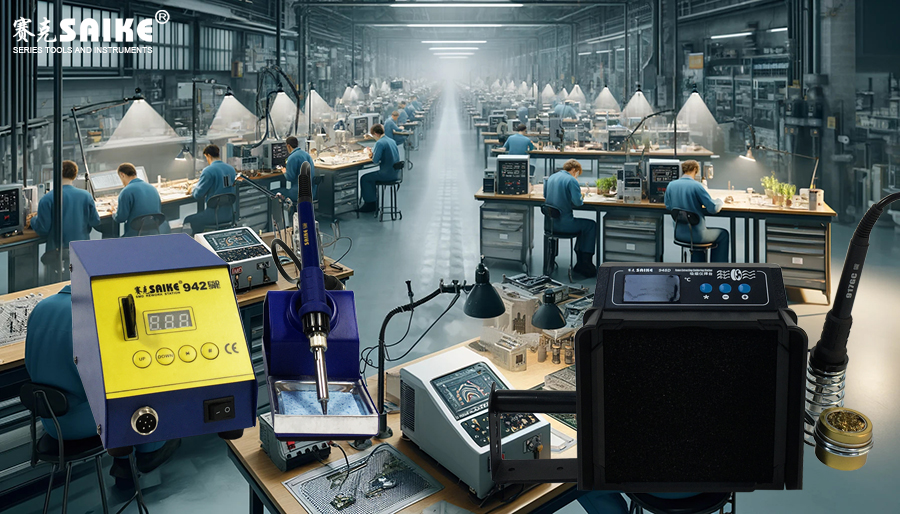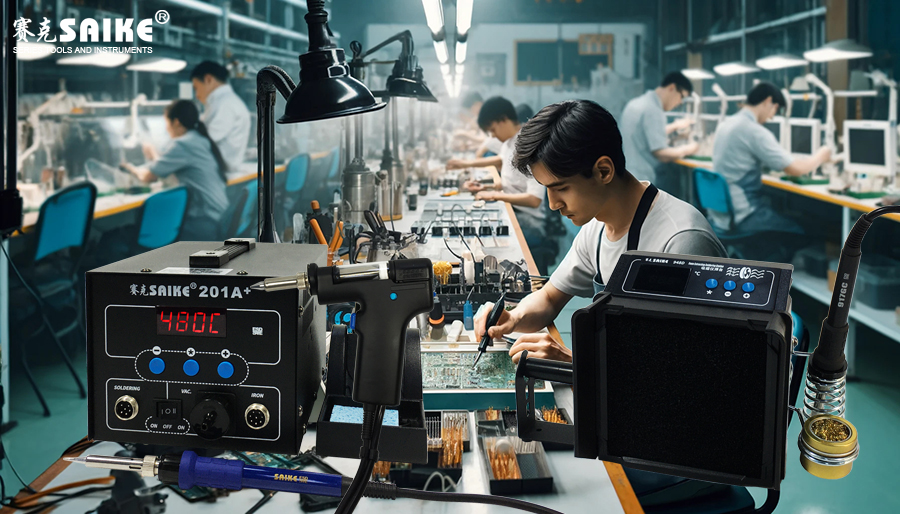
SK-YJ000HT-KP 100013
Soldering stations are commonly used tools in the electronic manufacturing and repair industries, providing essential support and functionality for various soldering tasks. The use of soldering stations encompasses multiple soldering methods, each with its specific application scenarios and characteristics. This article will introduce several common soldering methods on soldering stations and their characteristics to help users better understand and select appropriate soldering techniques.
I. Soft Soldering
Soft soldering is one of the most common soldering methods, primarily used for soldering electronic components and circuit boards. The solder used is typically a tin-lead alloy or a lead-free alternative, with a relatively low melting point (between approximately 180°C and 250°C).
Characteristics:
– Temperature Control: Soldering stations provide precise temperature control to prevent overheating and damaging sensitive electronic components.
– Wide Applicability: Suitable for most electronic assembly and repair work.
– Technical Requirement: Relatively easy to master, suitable for beginners and professionals.
II. Hard Soldering
Hard soldering typically refers to the use of metals with higher melting points than soft solder, such as silver soldering (using silver solder). This method requires higher temperatures than soft soldering, usually above 600°C.
Characteristics:
– High Strength: The welded joints have higher strength than soft soldering, suitable for applications that need to withstand significant mechanical or thermal stresses.
– Temperature Requirement: Requires a soldering station capable of providing higher temperatures to melt the solder.
– Application Limitations: Not suitable for all electronic components, as high temperatures may damage sensitive parts.
III. Lead-Free Soldering
With the implementation of environmental regulations, lead-free soldering is becoming increasingly common. Lead-free solder is typically composed of elements such as tin, silver, and copper, and its melting point is usually higher than traditional tin-lead solder.
Characteristics:
– Environmental Friendliness: Complies with environmental regulations such as ROHS, suitable for exported products and environmentally demanding occasions.
– Technical Requirements: More stringent temperature control is required to adapt to the changing melting point of the solder.
– Equipment Requirements: The soldering station needs to provide higher heating efficiency and temperature stability.
IV. Reflow Soldering
Reflow soldering is a method of soldering surface mount devices (SMDs) using solder paste (a mixture of adhesive and tiny solder balls) pre-placed on the printed circuit board. Hot air guns or preheaters on the soldering station are typically used for this method.
Characteristics:
– Automation: Suitable for automated production, allowing simultaneous soldering of multiple joints on the board.
– High Efficiency: Improves production efficiency and reduces manual operations.
– Temperature Distribution: Requires uniform heat distribution to prevent thermal stress damage.
V. Soldering Post-Processing
Cleaning and inspection after soldering are also essential parts of soldering work. Soldering stations are often equipped with solder suckers, hot air guns, and other tools for solder joint correction and cleaning.
Characteristics:
– Cleaning: Removes excess solder and oxides generated during soldering.
– Correction: Corrects soldering errors to improve soldering quality.
– Inspection: Uses a magnifying glass or microscope to inspect soldering quality.
VI. Conclusion
Choosing the appropriate soldering method depends on the specific requirements of the project, including material type, required mechanical strength, production efficiency, and environmental standards. Understanding the characteristics and application scenarios of various soldering methods can help users optimize the soldering process and improve product quality and production efficiency. As a multifunctional soldering tool, the configuration and functionality of the soldering station should fully consider the soldering methods to be used and the needs of the work environment.


